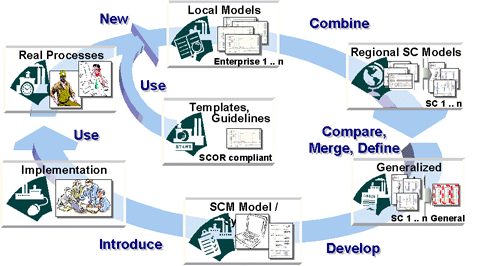FLEXINET
Intelligent Systems Configuration Services for Flexible Dynamic Global Production Networks (GPN)
The FLEXINET project works on a common reference ontology for global production networks. Within the project, IPK works especially on the development of a closer link between strategic and operational decision making. The metaphor underlying FLEXINET is ‘to start with a new business idea in the morning and have all the required data and networks understood by the afternoon’. This includes business cases of the new ideas and services, providing cost comparisons, risk analyses, network configuration evaluations and product service compliance requirements. It focuses on acceleration in the decision making within the establishment or adaptation of business ideas in new global production networks. To glue the strategic decision making and the tactical planning together, enterprise modelling techniques are applied such as the MO²GO system. This leads to a strategic view on the MO²GO models.
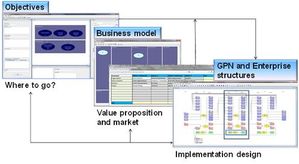
Acknowledgement
The research leading to these results has received funding from the European Community’s 7th Framework Programme under grant agreement no NMP2-SL-2013-608627.
Contact: Frank-Walter Jaekel | E-Mail
The new MO²GO Version 1.6 r3 is now available.
It provides advanced features for:
- Model based requirement management
- Generation of requirement handbooks in html and docx
- Model library to structure models
- Extensions for the model management in a distributed environment
- Extension of the handling of different languages for model
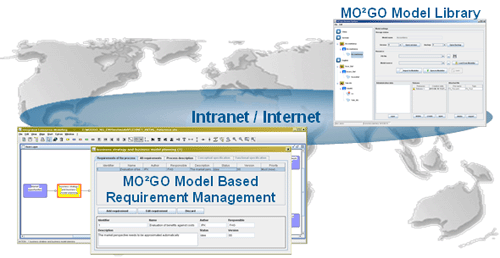
The model based requirement documentation and automatic requirement book generation has been successfully applied in industrial projects. It supports the requirement collection related to process steps.
Contact: Frank-Walter Jaekel | E-Mail
Manufacturing Execution System Implementation (MES)
Contact: Frank-Walter Jaekel | E-Mail
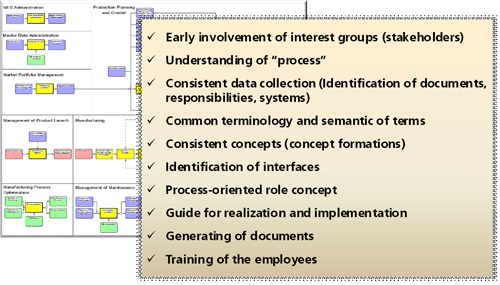
Why Enterprise Modelling for IT implementation
Today, the implementation of a process management and control system seems not a spectacular task. The principle technologies, IT-systems and also related standards such as ISA95 are well known. Also supporting organisations like the “Manufacturing Enterprise Solutions Association” (MESA) and guiding principles such as VDA 5600 do exist. However, the specific implementation of a manufacturing execution system incorporating business processes and manufacturing processes is still challenging and expensive. It is not only an IT task moreover it effects the enterprise organisation in terms of processes and organisational structure.
Success factors
Based on experiences from a number of IT implementation projects an effort should be made to build the mutual understanding between partners, reconcile their potentially different economic targets, match their process knowledge, make the implemented processes coherent and their implementation complete. The applied enterprise modelling approach and the resulting enterprise model was the foundation to archive these targets. The following factors of success have been identified:
- Motivation of all stakeholders
- Modular system architecture
- System granularity
- Communication and willingness of the IT provider to adapt the IT system
- Clear responsibilities
- Convinced management
The project procedures cover the project steps, results of the different project phases and required parallel actions such as the master data reorganisation and maintenance.

Project procedures
The enterprise modelling approach
The modelling method used was the integrated enterprise modelling (IEM) within the MO²GO system. The project starts with a business process analysis on the basis of a related enterprise model. The model covers processes, process interfaces, organisational units, IT systems in use, documents and other required resources. The modelling involved all process owners who might be affected by the discussed manufacturing execution system (MES) from the management area to the machine operators.
The resulting as-is-model has been modified by substituting the existing IT system fragments with functionalities of an expected integrated manufacturing execution system (MES). In parallel, a functional analysis supports the identification of the required functions related to the operational processes of planning, control and production. This leads to an initial model reflecting the process support of the MES system.
The results of the process analysis and functional analysis created the content of a functional requirement book and the foundation for an evaluation of performance indicators to approximate the return of invest (ROI). The ROI approximation was one element to convince the senior decision makers to continue with the project.
The results of the integration of MES components into the model have been added to the “functional requirement book”. It covers now the specialised system functionalities and a specific enterprise model reflecting the functions of the selected system in the operational processes.
The coherence of the different (local) activities was provided by the enterprise model expressing the interrelations between the different processes. For example missing transitions and interfaces between processes as well as the impact of decisions within the implementation of the MES are expressed by the model.
The modelling approach is supported by the enterprise modelling tool MO²GO applying the integrated enterprise modelling method (IEM). The method and tool supports a fast and consistent enterprise modelling approach and a good communication base. Extensions of the tool support consistency checks and the role definition in project step 9 and 10 as well as the test phase in project step 12.
IEM/MO²GO used in IPK certification.

Successful certification of the IPK according to ISO 9001 : 2000. The MO²GO system contributed to the quickness and the large acceptance of the quality management system. The generation at a push of a button of a web-based, permanently available and simply accessible Process Assistant assures the flexible maintenance of the living system.
Contact: Thomas Knothe | | E-Mail
From the auditor’s original statement (in german):
„Das Handbuch ist als reine EDV-Lösung konzipiert und wird über das Intranet den Mitarbeitern bereitgestellt. Ein strukturierter Prozessnavigator erleichtert den Anwendern den Zugriff zu den relevanten Prozessbeschreibungen und Dokumenten. Aufbau und Dokumentationsform können für die Komplexität der Organisation nicht nur als angemessen, sondern als vorbildlich bezeichnet werden.“
Integriertes Wertemanagement nachhaltig umgesetzt mit IUM/MO²GO Geschäftsprozessmodellen.
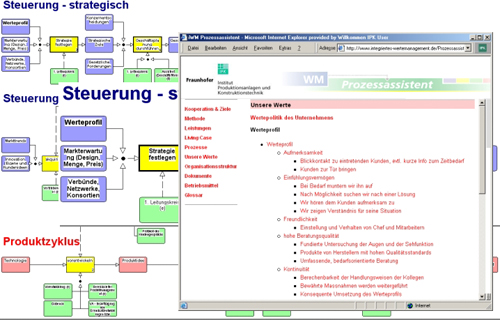
ISO/TS16949:2002 certification on the basis of enterprise-models
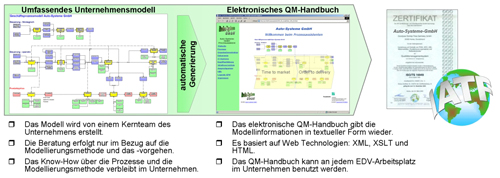
MO²GO Supply-Chain-Model as basis for the implementation of software support – project SPIDER-WIN
